Content
Fisher's Aconite (Latin Aconitum fischeri) is also called a fighter, since it belongs to the species of the same name in the Buttercup family. This herbaceous perennial has been cultivated for almost 2 centuries. The wrestler is appreciated not only for its decorative effect, but also for its healing properties.
Description of Aconite Fisher
In nature, Fischer's aconite prefers coastal forests, often found in large groups in clearings. Under natural conditions, the species grows in the Far East of Russia, in China and Korea. The main characteristics of a perennial:
- height 1-1.5 m;
- erect, bare stems, strong and round;
- the tip may be wriggling;
- in the inflorescence there is sometimes a barely noticeable pubescence;
- practical conical tubers;
- root leaf diameter up to 8 cm;
- the flowers form a loose raceme, the color is bright blue, less often white;
- the size of the upper deeply finger-cut leaves is up to 4 cm, they have 5-7 lobes 3-4 cm wide, the edges are coarse and sharply serrated;
- flowers with arched long lower and shortened close upper pedicels;
- the diameter of the middle thin and unequal perianth lobes is 1.5 cm, the length of the lower unequal and lanceolate ones is 1.4 cm, and the width is up to 0.5 cm;
- stamens glabrous, expanding from the middle;
- the length of the nectaries is up to 0.8 cm, the width is up to 0.5 cm, there is a wide swollen plastic, a short capitate spur and a lip bent upwards;
- 3 glabrous ovaries, weak pubescence on the ventral side;
- flowering occurs in July-September;
- development of additional tubers by autumn.
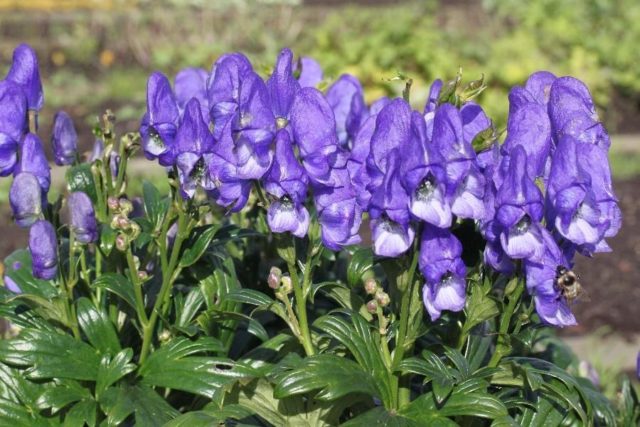
Fischer's Aconite has good frost resistance - the plant can withstand up to - 34 ° C
The wrestler is highly poisonous. This is mainly due to aconitine in the composition, only 3-4 mg of which is a lethal dose for humans. The action of the substance leads to depression of the nervous system and respiratory paralysis. This is what death entails.
With the strong toxicity of Fisher's aconite, its healing properties are side by side. The plant helps with many diseases, which is actively used in oriental medicine.
Application in landscape design
Fischer's Aconite blooms beautifully and attracts with dense and shiny dark green foliage. All this makes the plant popular in landscape design. It can be planted under trees or filled in between bushes.
The wrestler is a tall plant, therefore it is effective to place it along various buildings and fences.
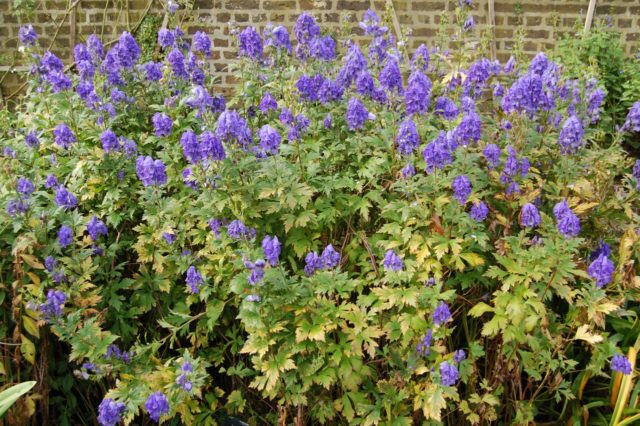
Fisher's Aconite can be a beautiful background or disguise
The wrestler looks good on his own. Neighbors for him can be:
- aquilegia;
- astilbe;
- delphiniums;
- goldenrod;
- irises;
- lilies;
- peonies;
- rudbeckia.

Fisher's Aconite looks good against the background of greenery, trees
The plant can be planted in flower beds, flower beds, mixborders, it looks good on the lawn.
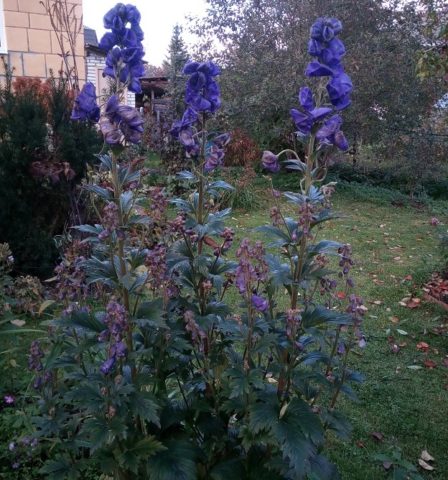
Fischer's Aconite looks impressive in small separate groups
Breeding features
Fischer's aconite is propagated by seeds, dividing the bush, cuttings, tubers. In the first case, the material can be bought or prepared by yourself.
It is recommended to divide the Fischer bush every 4 years in the spring. This is important for the renewal of the plant and the preservation of its decorative effect. The algorithm is simple:
- Dig in the selected bush.
- Carefully separate the part of the plant along with the roots. The seedling must have at least 3 buds.
- Place the separated fragment in a prepared hole.
- Cover the free space with earth, compact it.
- Water a new bush, mulch it.
Young shoots of aconite are used for grafting. Their length should be a maximum of 15 cm. Cuttings are cut in early May, then germinated in a mini-greenhouse. They are moved into open ground after the leaves appear.
Aconite tubers are propagated in autumn. They are first germinated to produce buds. Then the tubers are divided and placed in the pits, 2-3 fragments each. The growth buds must remain on the surface.
Planting and leaving
Fischer's Aconite is attractive for its unpretentiousness. He has a minimum of requirements for the landing site, and care consists in standard measures.
Recommended timing
Fischer's wrestler is planted with seeds in the spring or before winter. In the first case, the material is first tempered, then the seedlings are grown, and in the fall they are transferred to a permanent place. When sowing in winter, the seeds are prepared in a natural way, and sprout together in spring.
Site selection and soil preparation
Fischer's Aconite feels good both in the sun and in a shaded place. The site for this plant must meet the following requirements:
- the soil is light and loose;
- loam or sandy loam is recommended;
- remoteness of groundwater;
- good drainage.
The landing site must be prepared in advance. Do it in the spring. The selected area needs to be dug up, all weeds removed, peat and organic matter added. Preparation should be carried out when the ground is already warming up.
If the soil is dense, then sand, sawdust, peat should be added. Drainage is required.
When planting Fischer's aconite with seeds, the material is not buried in the soil, but distributed over its surface. Fine sand is poured on top.
Landing algorithm
Planting a plant is easy:
- Prepare the site.
- Make planting holes at a distance of 0.7 m. They should be slightly larger than the root system in size.
- Organize drainage at the bottom. For this, it is good to use expanded clay and large pebbles.
- Apply mineral fertilizers or compost.
- Carefully place the plants in the planting holes, deepening the root collars by 2 cm.
- Fill the free space with soil, compact it.
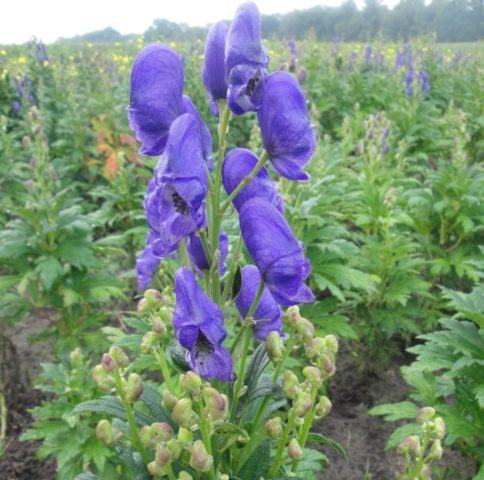
After planting, Fischer's aconite must be watered abundantly and mulched.
Watering and feeding schedule
The flower culture does not like excess moisture. She needs additional watering only in heat and drought. In this weather, it is enough to wet the plant every 2 weeks. Weeds should be removed after watering.
Fischer's Aconite is undemanding to fertilizers. Over time, the soil is depleted, therefore in the spring it is necessary to bring compost under the bushes. This makes the plant more hardy. After winter, an infusion of mullein or bird droppings is effective.
Additionally, the wrestler can be fed before flowering to make it brighter and more lush. For this, mineral fertilizers are used. Nitroammofoska is effective - 30-40 g per 10 liters of water.
Aconite can be fed twice more per season. Potassium-phosphorus fertilizers are applied at intervals of at least 3 weeks.
Loosening, mulching
After each watering or heavy rain, the soil around Fischer's aconite must be loosened. This prevents the formation of a crust on the surface.
To reduce weed growth and maintain soil moisture, mulch should be used. Use sawdust and pine needles effectively.
Flowering care
In order for the flowering of Fischer's aconite to be beautiful, it is necessary to monitor the condition of the soil. It is important that its top layer does not dry out.
Dead inflorescences should be removed regularly. This measure is important to preserve the decorative and splendor of the plant. Timely pruning stimulates re-flowering.
Preparing for winter
Fischer's Aconite tolerates frost well. Shelter should be taken care of if the region has frosty winters or little snow cover. To do this, you need to cut the plant shortly and cover its root system with dry peat.A layer of 20 cm is enough, which must be sprinkled with dry foliage.
Pests and diseases
The toxicity of Fisher's aconite does not save him from pests. One of them is aphid that feeds on plant sap. You can get rid of it with the help of the drug Aktara or spraying with folk remedies.
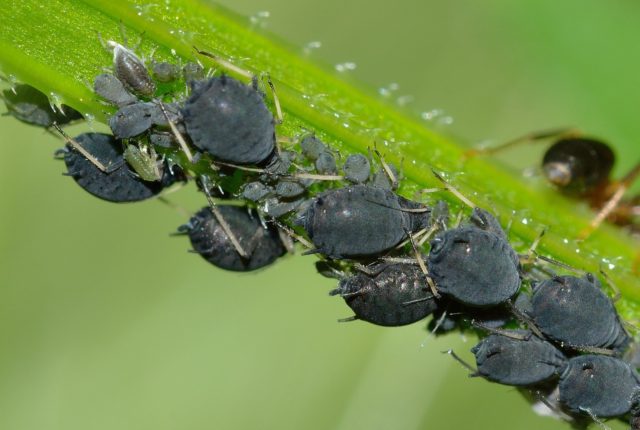
In small amounts, aphids can be washed off with water
Another enemy of aconite is a nematode. The affected plant weakens, grows and develops poorly, blooms poorly and may die. You can fight the pest with drugs Akarin, Fitoverm, organophosphate pesticides.
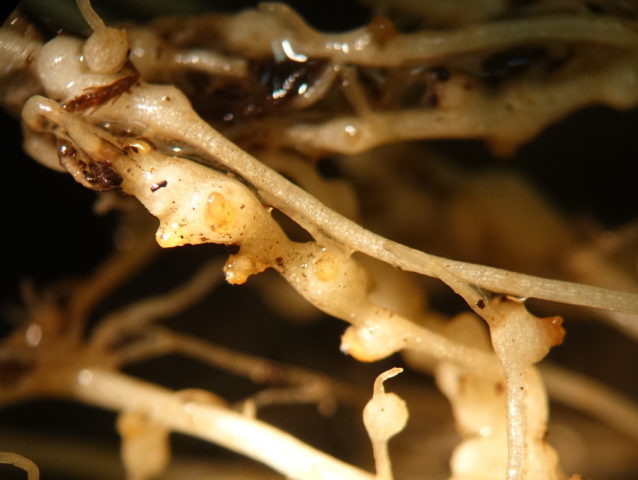
Prevention of nematodes is the introduction of bird droppings
Of the diseases, the culture is more often affected by powdery mildew. It manifests itself as a white bloom on the foliage and stem. Without timely intervention, the plant will die.
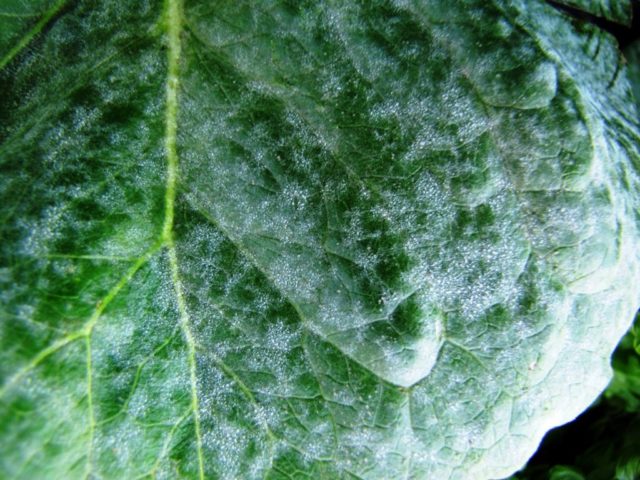
Effective preparations against powdery mildew Fundazol, Vitaros
Conclusion
Fisher's Aconite is unpretentious, therefore it is not difficult to grow it. It can be propagated in different ways, perennial care is minimal. The plant has medicinal properties, but it is poisonous.








